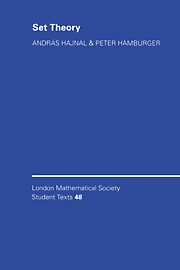Book contents
- Frontmatter
- Contents
- Preface
- Part I Introduction to set theory
- Appendix. An axiomatic development of set theory
- Part II Topics in combinatorial set theory
- 12 Stationary sets
- 13 Δ-systems
- 14 Ramsey's Theorem and its generalizations. Partition calculus
- 15 Inaccessible cardinals. Mahlo cardinals
- 16 Measurable cardinals
- 17 Real-valued measurable cardinals, saturated ideals
- 18 Weakly compact and Ramsey cardinals
- 19 Set mappings
- 20 The square-bracket symbol. Strengthenings of the Ramsey counterexamples
- 21 Properties of the power operation. Results on the singular cardinal problem
- 22 Powers of singular cardinals. Shelah's Theorem
- Hints for solving problems of Part II
- Bibliography
- List of symbols
- Name index
- Subject index
20 - The square-bracket symbol. Strengthenings of the Ramsey counterexamples
Published online by Cambridge University Press: 10 May 2010
- Frontmatter
- Contents
- Preface
- Part I Introduction to set theory
- Appendix. An axiomatic development of set theory
- Part II Topics in combinatorial set theory
- 12 Stationary sets
- 13 Δ-systems
- 14 Ramsey's Theorem and its generalizations. Partition calculus
- 15 Inaccessible cardinals. Mahlo cardinals
- 16 Measurable cardinals
- 17 Real-valued measurable cardinals, saturated ideals
- 18 Weakly compact and Ramsey cardinals
- 19 Set mappings
- 20 The square-bracket symbol. Strengthenings of the Ramsey counterexamples
- 21 Properties of the power operation. Results on the singular cardinal problem
- 22 Powers of singular cardinals. Shelah's Theorem
- Hints for solving problems of Part II
- Bibliography
- List of symbols
- Name index
- Subject index
Summary
In Theorem 14.3, we showed that Ramsey's Theorem cannot be generalized by writing an arbitrary infinite cardinal k in place of ω. According to the former theorem, we have
It occurred to P. Erdös that this counterexample may possibly be further strengthened by dividing the pairs of 2ℵ0 into, say, three classes in such a way that every set of cardinality ℵ1 should include a pair from each of the three classes. The questions raised by pursuing this idea have not been completely resolved even today. Before we can outline the present state of knowledge in this area, we would like to introduce some new concepts.
Definition 20.1.Let λ be a cardinal, γ ≥ 2, and let f : [A]λ → γ be a λ-partition of A with γ colors. We say that the set B ⊂ A is completely inhomogeneous with respect to f if f “[B]λ = γ.
Definition 20.2.Given cardinals k, λ, and μ, and an ordinal γ, the symbol
indicates that the following assertion holds:
For an arbitrary set X of cardinality k and for an arbitrary partition f : [X]λ → γ, there is a set Y with |Y| = μ that is not completely inhomogeneous with respect to f.
The negation of this assertion is denoted as
in the spirit of Definition 14.2.
We remark that, similarly to the way it was done in Definition 14.2, the symbol K → [kυ]λυ < γ can also be introduced. We will, however, not discuss this latter symbol here.
- Type
- Chapter
- Information
- Set Theory , pp. 234 - 242Publisher: Cambridge University PressPrint publication year: 1999



